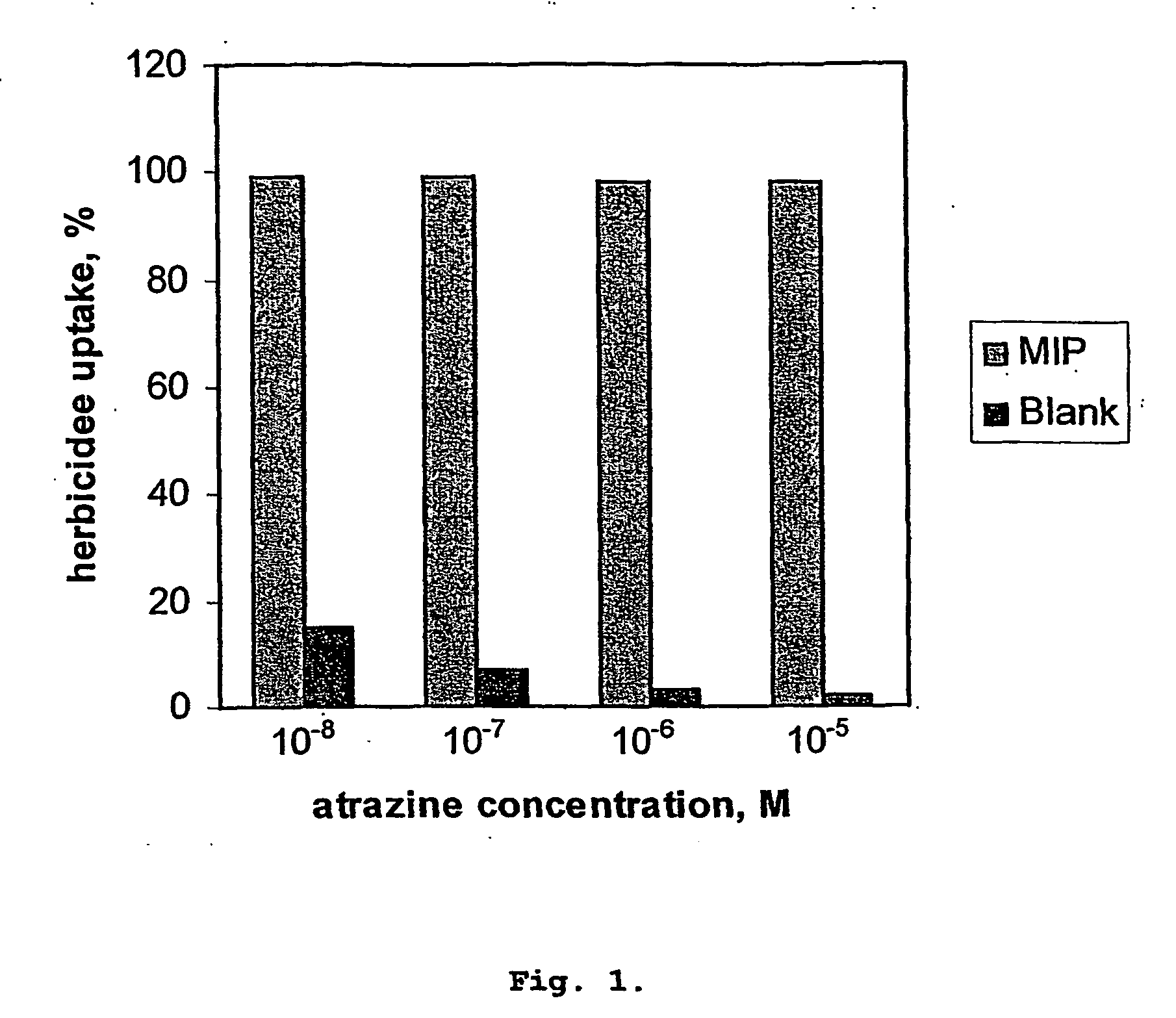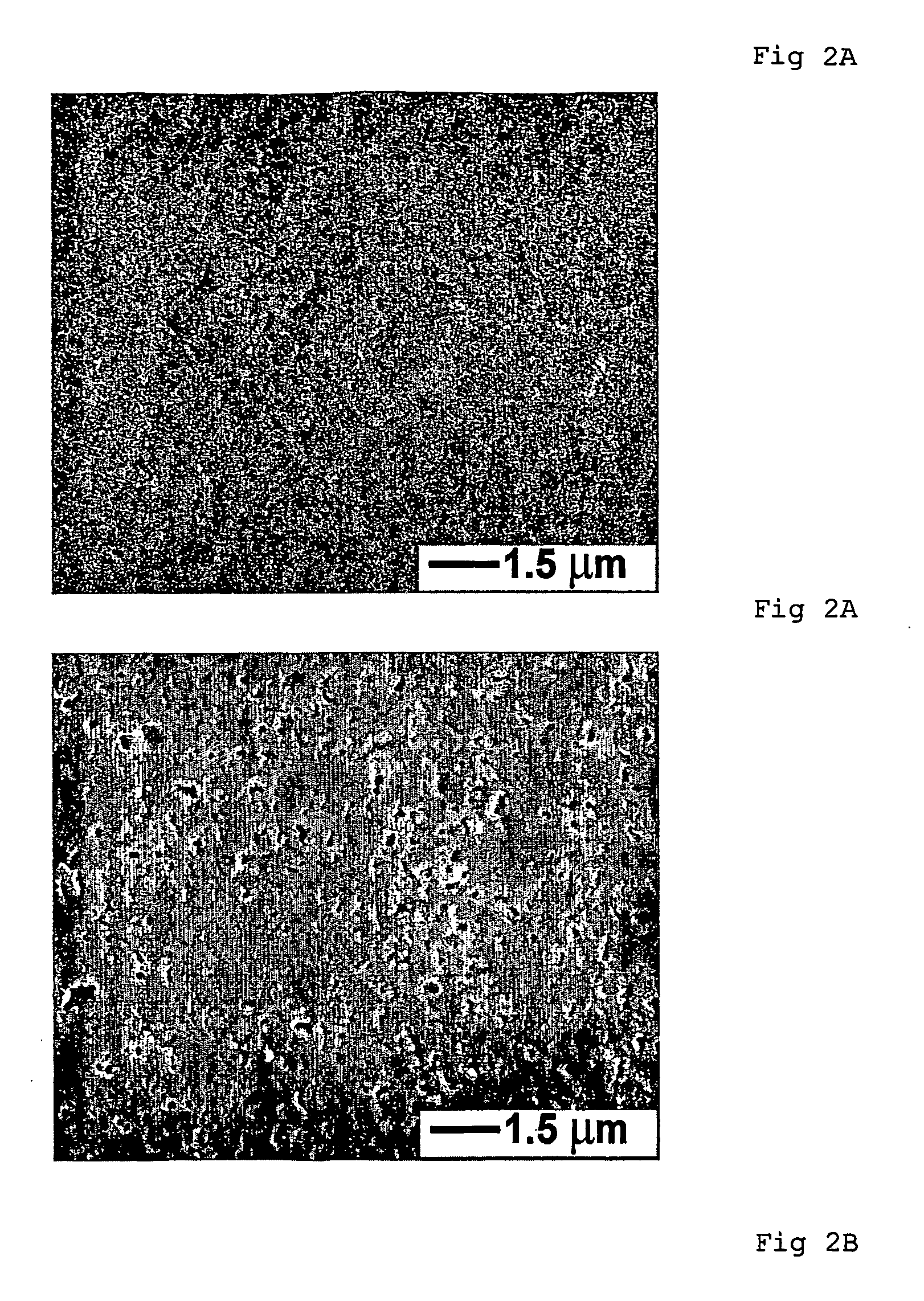Porous molecularly imprinted polymer membranes
- Summary
- Abstract
- Description
- Claims
- Application Information
AI Technical Summary
Benefits of technology
Problems solved by technology
Method used
Image
Examples
example 1
[0049] Synthesis of flexible and porous molecularly imprinted polymer membranes.
[0050] Porous thin, and flexible MIP membranes were synthesised from a mixture consisting of atrazine as a template (40 mg), methacrylic acid as a functional monomer (80.4 mg), tri(ethylene glycol)dimethacrylate as a cross-linking agent (616.6 mg), oligourethane acrylate as a plasticiser (102.9 mg), polyethylene glycol as a pore-forming component (120 mg), dimethylformamide (50 vol %) as solvent and 1,1′-azobis(cyclohexane carbonitrile) as an initiator of polymerisation (40 mg). The mixture was poured between two glass slides with a fixed distance between them of 60 μm and polymerisation was initiated by either UV-irradiation (λ=365 nm) or was carried out by heating at 80° C. for 1 hour. Reference polymeric membranes were synthesised with the same mixture of monomers, but in the absence of the template. To remove the template molecules and non-reacted monomers, cross-linker etc. and polyethylene glycol,...
example 2
[0052] Use of molecularly imprinted polymer membranes in solid-phase extraction of triazine herbicides.
[0053] A membrane synthesised as describe in Example 1 (with atrazine template) and having a diameter of 5 mm was placed between two chambers of a separation cell. A dilute solution of atrazine was passed across the membrane at a rate 0.5 ml / min under a pressure of 17×106 Nm−2. The membrane recognition properties were evaluated by measuring their capacity to adsorb atrazine from aqueous solutions (10−8-10−5 M). The herbicide concentrations in both feed and permeate solutions were determined using Gas Chromatography-Mass Spectrometry (GC / MS). The membranes demonstrated high adsorption ability towards atrazine. Repetition using the reference membranes showed negligible binding of atrazine (see FIG. 1).
example 3
[0054] Synthesis of membranes imprinted with ephedrine for separation of structurally similar compounds in HPLC mode.
[0055] Porous, thin and flexible membranes were synthesized from a polymerisation mixture consisting of (+)-ephedrine as a template (40 mg), hydroxyethyl methacrylate as a functional monomer (299 mg), tri (ethylene glycol) dimethacrylate as a cross-linking agent (1106 mg), oligourethane acrylate as a plasticiser (195 mg), a mixture of porogens constituting 50% of the volume of the polymerisation mixture and containing mineral oil (160 mg) and toluene; and 1,1′-azobis (cyclohexane carbonitrile) as an initiator of polymerisation (80 mg). The mixture was poured between two glass slides with the fixed distance between them of 60 μm and polymerisation was initiated by either UV-irradiation (λ=365 nm) or was carried out by heating at 80° C. for 1 hour. Reference polymeric membranes were synthesised with the same mixture of monomers, but in the absence of the (+) ephedrine....
PUM
| Property | Measurement | Unit |
|---|---|---|
| Diameter | aaaaa | aaaaa |
| Diameter | aaaaa | aaaaa |
| Diameter | aaaaa | aaaaa |
Abstract
Description
Claims
Application Information
 Login to View More
Login to View More - R&D
- Intellectual Property
- Life Sciences
- Materials
- Tech Scout
- Unparalleled Data Quality
- Higher Quality Content
- 60% Fewer Hallucinations
Browse by: Latest US Patents, China's latest patents, Technical Efficacy Thesaurus, Application Domain, Technology Topic, Popular Technical Reports.
© 2025 PatSnap. All rights reserved.Legal|Privacy policy|Modern Slavery Act Transparency Statement|Sitemap|About US| Contact US: help@patsnap.com



